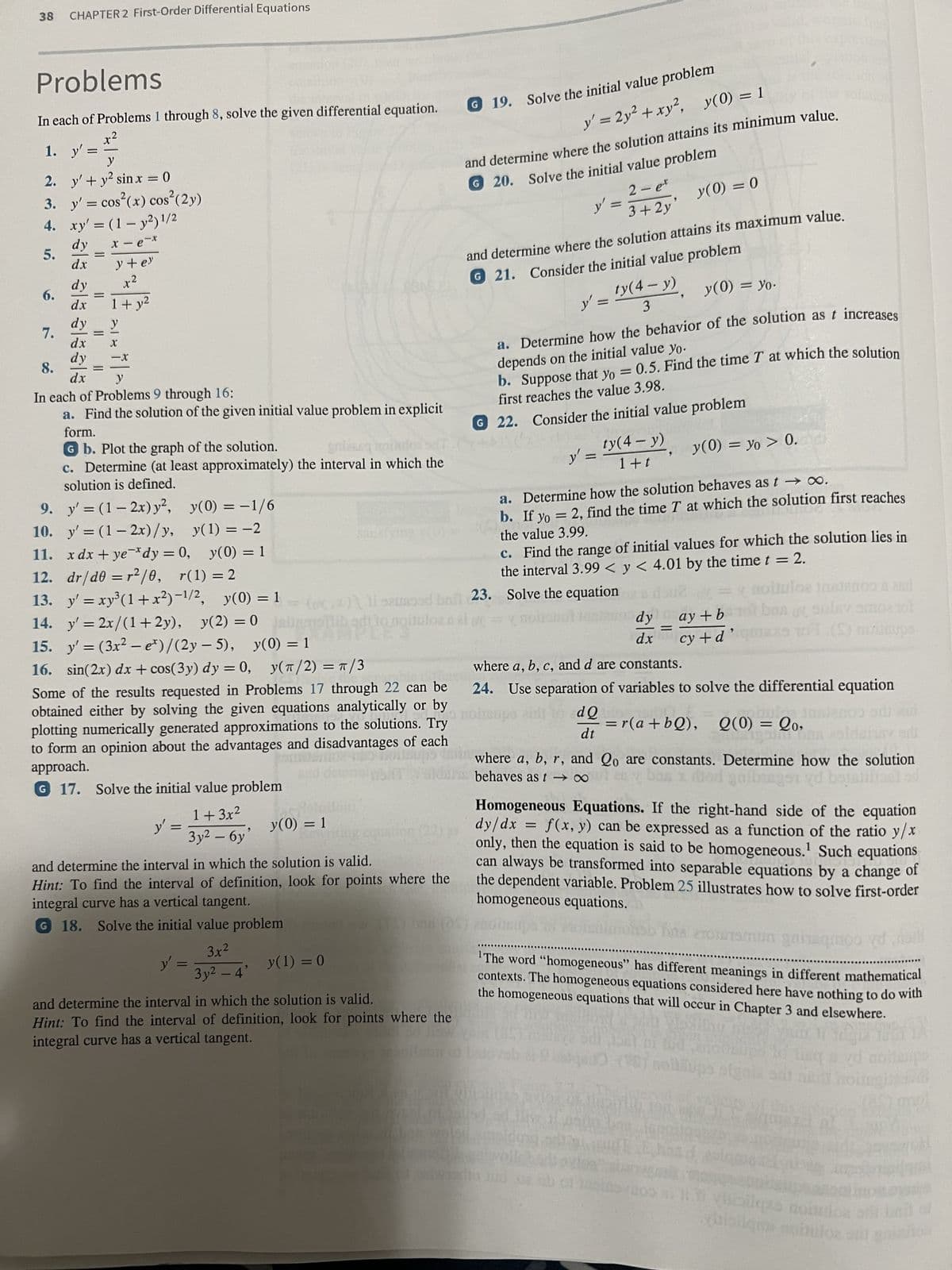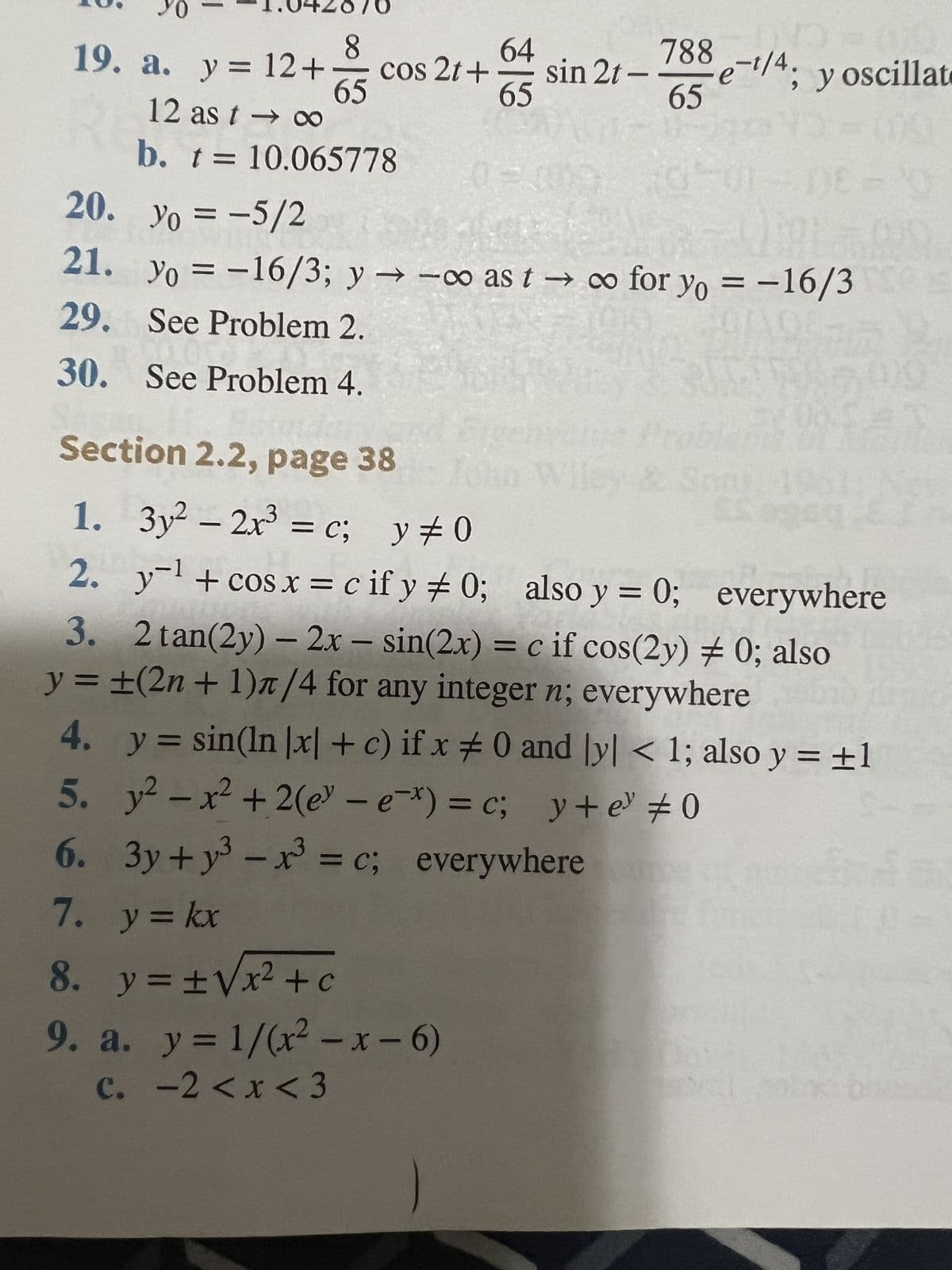y' = (1-2x) y², y(0) = -1/
Advanced Engineering Mathematics
10th Edition
ISBN:9780470458365
Author:Erwin Kreyszig
Publisher:Erwin Kreyszig
Chapter2: Second-order Linear Odes
Section: Chapter Questions
Problem 1RQ
Related questions
Question
9

Transcribed Image Text:38 CHAPTER 2 First-Order Differential Equations
Problems
In each of Problems 1 through 8, solve the given differential equation.
x²
1. y'=
=
2.
3.
4.
5.
6.
7.
y
y' + y² sinx = 0
y' = cos(x) cos² (2y)
xy' = (1 - y2) 1/2
x-e-x
al ala alaala
dy
dx
dy
dy x²
dx
=
dy
=
||
y + ey
=
1+ y²
8.
In each of Problems 9 through 16:
a. Find the solution of the given initial value problem in explicit
form.
G b. Plot the graph of the solution.
c. Determine (at least approximately) the interval in which the
solution is defined.
9. y' = (1-2x) y²,
y(0) = -1/6
10. y'=(1-2x)/y,
y(1) = -2
11. xdx+ye dy = 0, y(0)
-X
= 1
12. dr/d0 = r²/0, r(1) = 2
13. y'=xy³ (1+x²)-¹/², y(0) = 1
14. y'= 2x/(1+2y), y(2)=0 alibadtto noituloer
15. y' = (3x² - e*)/(2y-5), y(0) = 1
16. sin(2x) dx + cos(3y) dy = 0, y(π/2) = π/3
o the
Th
Some of the results requested in Problems 17 through 22 can be
obtained either by solving the given equations analytically or by
plotting numerically generated approximations to the solutions. Try
to form an opinion about the advantages and disadvantages of each
approach.
G 17. Solve the initial value problem
dx y
y' =
1+3x²
Зу2 — бу
y' =
"
3x²
3y² - 4'
and determine the interval in which the solution is valid.
Hint: To find the interval of definition, look for points where the
integral curve has a vertical tangent.
G 18. Solve the initial value problem
y(0) = 1
y(1) = 0
G 19. Solve the initial value problem
and determine the interval in which the solution is valid.
Hint: To find the interval of definition, look for points where the
integral curve has a vertical tangent.
y' = 2y² + xy², y(0) = 1
and determine where the solution attains its minimum value.
G 20. Solve the initial value problem
2-et
3 + 2y
y' =
and determine where the solution attains its maximum value.
G21. Consider the initial value problem
y' =
y(0) = yo.
G 22.
y'
ty(4- y)
3
a. Determine how the behavior of the solution as t increases
depends on the initial value yo.
b. Suppose that yo = 0.5. Find the time T at which the solution
first reaches the value 3.98.
=
Consider the initial value problem
(.*)\ 11 sausood bail 23. Solve the equation
ty(4- y)
1+t
y(0) = 0
9
a. Determine how the solution behaves as t → ∞.
b. If yo = 2, find the time T at which the solution first reaches
the value 3.99.
dy
dx
c. Find the range of initial values for which the solution lies in
the interval 3.99 < y < 4.01 by the time t = 2.
=
y(0) = yo > 0.
aoiuloa toetanoo & 2nd
ay+b 1 bas of sulny amos tot
cy + d
TOT (S) nailsups
9
where a, b, c, and d are constants.
24. Use separation of variables to solve the differential equation
dQ
dt
=r(a+bQ), Q(0) = 20,
igoin 608
where a, b, r, and Qo are constants. Determine how the solution
behaves as t→∞
garbingen yd bajariliant od
Homogeneous Equations. If the right-hand side of the equation
dy/dx = f(x, y) can be expressed as a function of the ratio y/x
only, then the equation is said to be homogeneous.¹ Such equations
LORE
can always be transformed into separable equations by a change of
the dependent variable. Problem 25 illustrates how to solve first-order
homogeneous equations.
The word “homogeneous" has different meanings in different mathematical
contexts. The homogeneous equations considered here have nothing to do with
the homogeneous equations that will occur in Chapter 3 and elsewhere.
Vosling me
neillups sign
000
nitit
yd moitampo
ili lisilqzs
bibliqmi apbuloz

Transcribed Image Text:19. a. y = 12 +
12 as t → ∞
b. t = 10.065778
8
20.
21. yo
Yo
29. See Problem 2.
30. See Problem 4.
1.
2.
3.
y =
4.
5.
6.
7.
65
cos 2t+
Section 2.2, page 38
3
3y² - 2x³ = c; y = 0
-1
y-¹ + cos x = cify # 0;
64
65
y = kx
8. y = ± √x² +c
9. a. y = 1/(x²-x-6)
c. -2 < x < 3
3
sin 2t -
e-t/4
; y oscillate
yo = -5/2
= -16/3; y →→∞o as to for yo = -16/3
788
65
DE-
also y = 0; everywhere
2 tan(2y) - 2x - sin(2x) = c if cos(2y) # 0; also
±(2n + 1)π/4 for any integer n; everywhere
y = sin(ln |x| + c) if x # 0 and ly| < 1; also y = ±1
y² - x² +2(e-ex) = c;
y+e³ #0
3y+y³ - x³ = c; everywhere
JE 1500
Expert Solution
This question has been solved!
Explore an expertly crafted, step-by-step solution for a thorough understanding of key concepts.
This is a popular solution!
Trending now
This is a popular solution!
Step by step
Solved in 3 steps with 2 images

Recommended textbooks for you

Advanced Engineering Mathematics
Advanced Math
ISBN:
9780470458365
Author:
Erwin Kreyszig
Publisher:
Wiley, John & Sons, Incorporated

Numerical Methods for Engineers
Advanced Math
ISBN:
9780073397924
Author:
Steven C. Chapra Dr., Raymond P. Canale
Publisher:
McGraw-Hill Education

Introductory Mathematics for Engineering Applicat…
Advanced Math
ISBN:
9781118141809
Author:
Nathan Klingbeil
Publisher:
WILEY

Advanced Engineering Mathematics
Advanced Math
ISBN:
9780470458365
Author:
Erwin Kreyszig
Publisher:
Wiley, John & Sons, Incorporated

Numerical Methods for Engineers
Advanced Math
ISBN:
9780073397924
Author:
Steven C. Chapra Dr., Raymond P. Canale
Publisher:
McGraw-Hill Education

Introductory Mathematics for Engineering Applicat…
Advanced Math
ISBN:
9781118141809
Author:
Nathan Klingbeil
Publisher:
WILEY

Mathematics For Machine Technology
Advanced Math
ISBN:
9781337798310
Author:
Peterson, John.
Publisher:
Cengage Learning,

